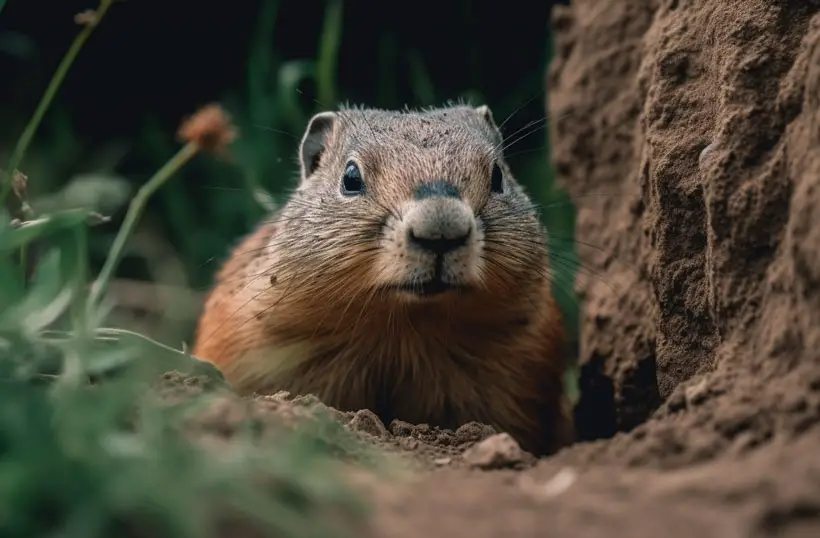What Attracts Gophers? Understanding Gopher Attraction Factors And Prevention Methods
Gophers are common garden pests that can cause extensive damage to lawns and gardens. These small, burrowing rodents are notorious for their ability to tunnel through soil and feed on the roots of plants. They leave behind unsightly holes and uprooted vegetation.
While gophers may seem like an inevitable threat to gardeners, understanding the factors that attract them can help minimize their impact on your garden. Gardeners and lawn enthusiasts know all too well the frustration that comes with gopher damage.
So, what attracts gophers? Gophers are particularly active in areas with abundant food sources, such as deep-rooted plants such as carrots. They are also attracted to lawns with suitable soils which are easy to burrow through.
Therefore, it is essential to understand the factors that attract gophers to your garden. This will help you implement effective prevention methods to keep them at bay.
In this article, we will explore the various gopher attraction factors. We will also discuss various prevention methods that you can use to keep these pests from destroying your lawn and garden. These methods range from natural pest control methods to lawn maintenance. So, let’s get started!
Factors That Attract Gophers
To effectively control gopher populations, let’s discuss what attracts gophers to your garden. This chapter will also enlighten different species of gophers attracted to different soil types. And how gopher attraction factors can vary depending on the region and climate.

Factors That Attract Gophers To Gardens And Lawns
Here are the factors that attract gophers to your lawns.
Soil Type And Moisture
Gophers are attracted to loose, moist soil because it is easy to dig through. If your garden or lawn has soil that is as such, gophers are more likely to be attracted to it. Gophers cause plant damage and root damage and disrupt irrigation systems.

While their digging behavior can damage crops and gardens, research has shown a significant positive relationship between gophers and soil health. For example;
- They aerate the soil through their burrowing. This can improve soil structure and increase the infiltration of water and nutrients.
- In addition, their digging can bring up deeper layers of soil to the surface, which can help to mix and distribute organic matter.
- Gophers also create tunnels that serve as conduits for water to move through the ground, reducing runoff and erosion.
- These tunnels can also provide habitat for other organisms, including earthworms, which further improve soil quality.
Therefore, it is essential to find a balance between the benefits and drawbacks of gophers. Take appropriate measures to control their populations in areas where they are causing significant damage.
Vegetation
Gophers are herbivores, which means they primarily eat plants. They are attracted to gardens and lawns with various plants, including flowers, shrubs, vegetables, and grass. This is because these types of plants are easy for them to chew through and provide a good source of moisture.
Gophers are also attracted to plants with deep roots, such as carrots, potatoes, and sweet potatoes. If your garden or lawn has many plants with tasty roots, gophers will likely be attracted to them.
Food Availability
In addition to vegetation, gophers are attracted to areas where food is readily available. This can include gardens, orchards, and fields where crops are grown.

Climate And Season
Gophers are most active in the spring and fall when the soil is moist, and temperatures are mild. During the summer, when the soil is dry, and temperatures are high, gophers may hibernate.
In areas with mild winters, gophers may remain active year-round. They may burrow deeper into the soil in colder regions to escape freezing temperatures.
Lack Of Predators
Gophers have few natural predators, which means they can thrive in areas without much threat. Research has shown that gophers may thrive where predators are present, as they can avoid detection by staying underground.
Water
Water is also one of the factors that attract gophers. Although gophers obtain most of their water from their food, they must also drink water to survive.
Gophers can be attracted to your garden or lawn with a water source, such as a pond, stream, or birdbath. They will dig tunnels to get to the water source, harming plants and lawns.
Are Different Species Of Gophers Attracted To Different Soil Types And Vegetation?
Yes, different gopher species are attracted to different soil types and vegetation. For example, the pocket gopher is often found in well-drained soils rich in organic matter.

They prefer grasslands and agricultural fields with fertile loam soil and a thick mat of vegetation. These gophers feed on roots, tubers, and bulbs of grasses.
On the other hand, the Botta gopher is found in various soil types, including sandy and loamy soils. They prefer habitats with sparse vegetation, such as desert scrub and chaparral. The Botta gopher feeds on underground plant parts, including roots, bulbs, and tubers.
How Do Gopher Attraction Factors Vary Depending On The Region And Climate?
Gophers are attracted to areas with dense vegetation and moist soil in regions with a warm and humid climate, such as tropical rainforests.
The lush vegetation provides abundant food sources for gophers, such as roots, tubers, and other underground plant parts. Also, the moist soil is ideal for burrowing and creating tunnel systems.
In contrast, in regions with a more arid or semi-arid climate, such as deserts or grasslands, gophers are attracted to sandy or loamy soil that is easy to burrow into. These regions may also have sparse vegetation, which can make gophers more reliant on underground food sources.

The specific types of plants and vegetation that gophers are attracted to can also vary depending on the region.
For example, gophers in the western United States are known to be particularly fond of alfalfa. On the other hand, gophers in the Great Plains region of the United States are attracted to crops such as wheat, oats, and barley.
In addition to environmental factors, the behavior of gophers themselves can also vary depending on the region and climate.
For example, gophers in regions with milder climates may be active year-round. In contrast, gophers in areas with harsh winters may become less active or even hibernate during the colder months.
Preventing Gopher Damage
Animal burrowing behavior can quickly destroy your lawn or garden if left unchecked. Fortunately, you can take steps to prevent gopher damage and protect your outdoor space.

Prevention Methods
1. Garden Fencing
Installing a barrier around your garden or lawn is one of the most effective ways to prevent gophers from getting in.
- Use a wire mesh fence with a small grid size (1 inch or less) and bury the bottom edge at least 1-2 feet underground to prevent gophers from digging underneath.
- The fence should also extend several feet above the ground to prevent gophers from climbing over it.
However, the drawback of garden fencing is that it can be costly and time-consuming to install.
2. Natural Pest Control Methods

Natural pest control methods such as predator urine or planting deterrent plants can deter gophers.
- Predator urine, such as that of coyotes or bobcats, can be purchased at garden supply stores and sprayed around the perimeter of the garden.
- You can also use plant-based repellents like castor oil or garlic spray, which can deter gophers from feeding on your plants.
- Plant physiology can also help in gopher damage prevention. Choose plants resistant to gophers, such as lavender, mint, rosemary, and sage. These plants have a strong scent that repels gophers.
- You can also plant bulbs in wire cages to protect them from gopher damage.
The benefit of natural pest control methods is that they are eco-friendly and do not harm the environment. However, these methods may not be as effective as other measures and may require frequent application.
3. Companion Planting
This involves planting plants together that have a symbiotic relationship, such as planting beans and corn.
- Beans release nitrogen into the soil, benefiting corn growth, while corn provides a support structure for climbing beans. Gophers tend to avoid areas with diverse plantings, so companion planting can help deter them from a garden.
- You can also cultivate plants together, such as daffodils, alliums, or fritillaries, near vulnerable plants. This can help repel gophers because they don’t like the smell or taste of these plants.
The drawback of this method is that it may require more planning and knowledge of companion planting to be effective.
Control Methods
1. Trapping
Trapping is a method of controlling gopher populations that involve setting traps in active gopher tunnels. Various types of traps are available, such as box, snap, and tunnel traps. Once a gopher is caught, it can be humanely relocated to a different area.

The benefit of trapping is that it is an effective method of controlling gopher populations, and it does not harm the environment. However, it can be time-consuming to set and check traps regularly, and there is a risk of accidentally catching other animals.
2. Chemical Repellents
Chemical repellents are another method of controlling gopher populations. Repellents can be applied to the soil around plants or directly into gopher tunnels. The repellents work by emitting an odor that repels gophers.
However, the drawback of using chemical repellents is that they can harm the environment and other animals. Additionally, they may require a frequent application to be effective.
3. Wildlife Management Practices
Understanding wildlife behavior can also help prevent gopher damage. Gophers are active during the day and prefer to burrow in quiet, undisturbed areas. Regular lawn maintenance, e.g., turning over your garden, can make the area less attractive to gophers.
If you’re dealing with gophers in your yard and want to learn more about how to prevent them from eating your garden or how to trap and catch them, be sure to check out our articles on how to prevent gophers from eating your garden and how to trap and catch a gopher. Our piece on how to prevent gophers from eating your garden provides practical tips to keep these pests at bay, while our article on how to trap and catch a gopher offers a step-by-step guide to catching them.FAQs
Here are other related questions you may find helpful.
Q: Can gophers cause damage to underground utility lines and pipes?
Yes, gophers can cause damage to underground utility lines and pipes. Their burrowing behavior can damage underground infrastructure, which can be costly.
Q: Do gophers prefer certain types of soil over others?
Yes. Different gopher species thrive in loose, well-drained soils that are easy to dig, such as sandy loam, loamy sand, and loam.
Q: Are there any regulations governing the control and prevention of gophers?
Yes, gophers may be legally protected in some areas and cannot be killed or trapped without a permit. However, there may be no restrictions on controlling gophers in other regions.
Conclusion
Understanding the factors that attract gophers is critical to preventing damage and maintaining a healthy garden.
- Soil quality, water availability, and the presence of plants with deep root systems are all significant factors in gopher attraction.
- Different species of gophers are attracted to different soil types and vegetation.
- Preventing gopher damage requires a multifaceted approach that combines natural and human-made prevention methods.
- Garden pest control methods such as natural pest control, companion planting, and garden fencing can effectively prevent gopher damage.
- Good lawn maintenance and soil health are also essential.
- Effective wildlife management practices are also helpful such as using humane traps to capture and relocate gophers and implementing habitat modification techniques to discourage gophers from burrowing in your garden or lawn.
Also, more research is needed to better understand gopher impact on ecosystems. This includes interactions with other species and potential ecological consequences of gopher damage.
Furthermore, there is a need for research into more effective and long-term gopher prevention methods that can minimize harm to both gophers and the environment.
In summary, preventing gopher damage requires a comprehensive approach that considers the factors that attract gophers and effective pest control methods and wildlife management practices.
Each method has its benefits and drawbacks, and gardeners should choose the procedure or combination of ways that work best for their specific situation.




